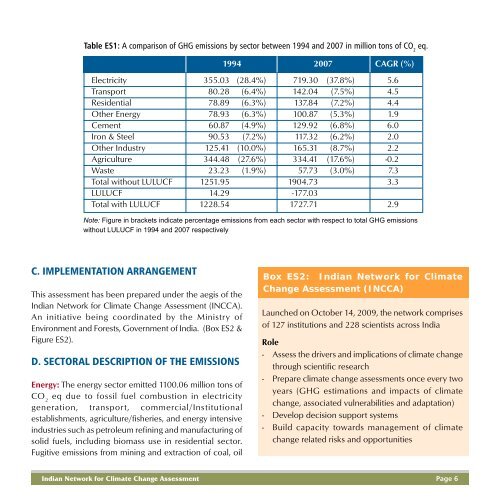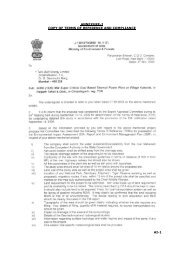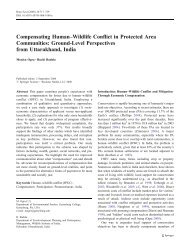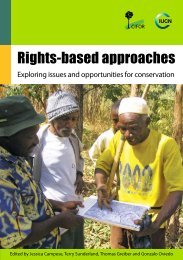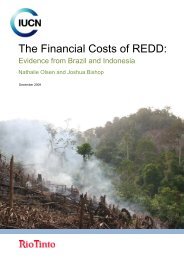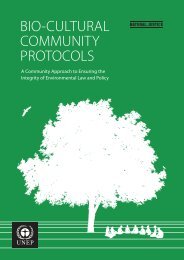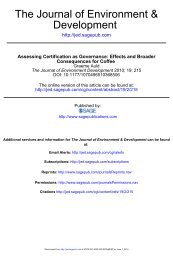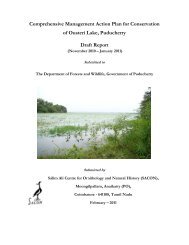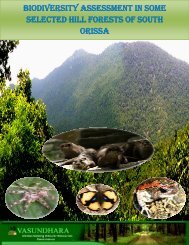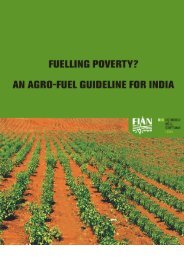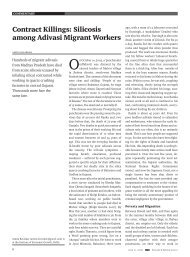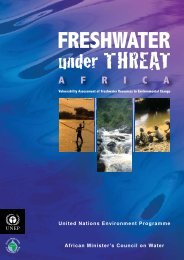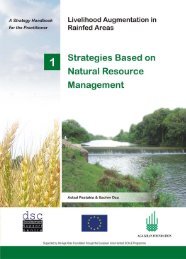India: Greenhouse Gas Emissions 2007 - Ministry of Environment ...
India: Greenhouse Gas Emissions 2007 - Ministry of Environment ...
India: Greenhouse Gas Emissions 2007 - Ministry of Environment ...
You also want an ePaper? Increase the reach of your titles
YUMPU automatically turns print PDFs into web optimized ePapers that Google loves.
Table ES1: A comparison <strong>of</strong> GHG emissions by sector between 1994 and <strong>2007</strong> in million tons <strong>of</strong> CO 2<br />
eq.<br />
1994 <strong>2007</strong> CAGR (%)<br />
Electricity 355.03 (28.4%) 719.30 (37.8%) 5.6<br />
Transport 80.28 (6.4%) 142.04 (7.5%) 4.5<br />
Residential 78.89 (6.3%) 137.84 (7.2%) 4.4<br />
Other Energy 78.93 (6.3%) 100.87 (5.3%) 1.9<br />
Cement 60.87 (4.9%) 129.92 (6.8%) 6.0<br />
Iron & Steel 90.53 (7.2%) 117.32 (6.2%) 2.0<br />
Other Industry 125.41 (10.0%) 165.31 (8.7%) 2.2<br />
Agriculture 344.48 (27.6%) 334.41 (17.6%) -0.2<br />
Waste 23.23 (1.9%) 57.73 (3.0%) 7.3<br />
Total without LULUCF 1251.95 1904.73 3.3<br />
LULUCF 14.29 -177.03<br />
Total with LULUCF 1228.54 1727.71 2.9<br />
Note: Figure in brackets indicate percentage emissions from each sector with respect to total GHG emissions<br />
without LULUCF in 1994 and <strong>2007</strong> respectively<br />
C. IMPLEMENTATION ARRANGEMENT<br />
This assessment has been prepared under the aegis <strong>of</strong> the<br />
<strong>India</strong>n Network for Climate Change Assessment (INCCA).<br />
An initiative being coordinated by the <strong>Ministry</strong> <strong>of</strong><br />
<strong>Environment</strong> and Forests, Government <strong>of</strong> <strong>India</strong>. (Box ES2 &<br />
Figure ES2).<br />
D. SECTORAL DESCRIPTION OF THE EMISSIONS<br />
Energy: The energy sector emitted 1100.06 million tons <strong>of</strong><br />
CO 2<br />
eq due to fossil fuel combustion in electricity<br />
generation, transport, commercial/Institutional<br />
establishments, agriculture/fisheries, and energy intensive<br />
industries such as petroleum refining and manufacturing <strong>of</strong><br />
solid fuels, including biomass use in residential sector.<br />
Fugitive emissions from mining and extraction <strong>of</strong> coal, oil<br />
Box ES2: <strong>India</strong>n Network for Climate<br />
Change Assessment (INCCA)<br />
Launched on October 14, 2009, the network comprises<br />
<strong>of</strong> 127 institutions and 228 scientists across <strong>India</strong><br />
Role<br />
- Assess the drivers and implications <strong>of</strong> climate change<br />
through scientific research<br />
- Prepare climate change assessments once every two<br />
years (GHG estimations and impacts <strong>of</strong> climate<br />
change, associated vulnerabilities and adaptation)<br />
- Develop decision support systems<br />
- Build capacity towards management <strong>of</strong> climate<br />
change related risks and opportunities<br />
<strong>India</strong>n Network for Climate Change Assessment<br />
Page 86


